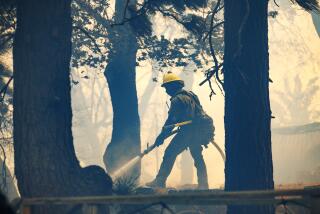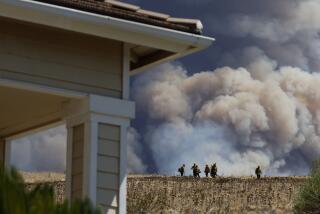Crews Prepare to Face Fire Advancing on City
SHOW LOW, Ariz. — As firefighters readied hoses to extinguish house fires Monday, crews frantically cut small pine trees behind homes at the forest edge in a desperate effort to slow a monstrous fire that marched to within a mile of this mountain town.
The fire has destroyed at least 329 homes and 16 buildings in surrounding communities. It outpaced efforts to divert it from this city of 7,700 Saturday night, forcing residents to flee. The fire, the largest in Arizona history, had burned 331,000 acres, or 517 square miles, an area bigger than Los Angeles.
Smoke and falling ash cloaked Show Low, building tension among firefighters and causing some of the region’s 30,000 evacuees to wonder about their futures.
Some, like James Christian of Show Low, said they were resigned to losing their homes and had learned a lesson about forest living.
He would take his insurance money and rebuild, Christian said, biding his time at a Red Cross shelter at Holbrook, about 50 miles to the north. “But it sure will not be under shade trees,” he said, referring to the ponderosa pines that surround his home.
Emergency crews here patrolled empty streets, looking for spot fires ignited by firebrands in trees and rooftops, as Show Low awaited its fate.
Fire officials said nothing stood in the way of the fire’s forced entry into the city’s western neighborhoods.
“We’ll give up the forest to that point,” said U.S. Forest Service spokesman Jim Paxon. “Those houses are being prepared for a fire. If the fire comes out [of the forest], we’ll catch it where we can defend it. We’ll have pavement, green lawns, metal buildings.”
Firefighters, positioned behind a neighborhood closest to the oncoming flames, wielded axes to create a 100-foot buffer free of small ponderosa pines that otherwise would funnel flames to larger trees hanging over the rooftops of manufactured homes.
“If we could have done prescribed burning to control the fuels near the ground, that would have helped,” said one crew boss, John Patterson, echoing the sentiment of others--including Gov. Jane Dee Hull--that thinning the forests would have decreased the intensity of wildfires.
In front of the homes, more than a dozen fire engines were parked on the street. Their crews were powerless for the time being, so they sat in lawn chairs waiting for what they believed was inevitable.
“We’re hoping nothing comes through, but if it does, we expect it to come up right behind us,” Phoenix Fire Department Battalion Chief Phillip Yeager said. If the house fires collectively grew too hot, his crews would retreat to a nearby church parking lot and return half an hour later to save what they could.
On Saturday, a three-mile-wide wall of flames 200 feet high was roaring toward the city, but it cooled Sunday and Monday as temperatures fell slightly into the upper 80s. The overnight humidity also helped when it climbed to more than 40%, returning moisture to trees that during the day were dried by desert-like, single-digit humidity.
Firefighters spent the early Monday morning hours building fire lines with bulldozers and carefully controlled burnouts to the southwest of the city. But smoke between the fire and the city was so dense Monday that air tankers dropping fire retardant focused instead on the fire’s northern front, where still more homes were threatened.
Even though the fire that was headed for Show Low out of the west appeared less treacherous, Paxon warned that flames could still feed on “jackpots of fuel” that would send fiery ash into town.
The only question, he said, was whether hundreds of firefighters positioned throughout the city would be able to extinguish any rooftop fires before they engulf homes.
The fire had grown so large the forest service set up four different command posts. The blaze, now called the Rodeo-Chediski fire, is the combination of two fires that merged Sunday.
More than 2,200 firefighters had been assigned to the fire, and Paxon said that twice that many were expected by today.
In Holbrook, Show Low resident Gerald R. Vermuele, 68, was resigned to the fact he would lose his home and his treasured antiques. Sitting next to his friend Jim Christian, Vermuele said, “I’ve been collecting them for 25 to 30 years.” His favorite: an 1850s serpent-head flowerpot stand.
“What can you do about it?” he said of the fire. “It’s just old mother nature.”
“And she’s not been very kind to us, the old bag,” added Christian.
Sandy Ramsey, a 69-year-old resident of Overgaard, which already had been swarmed by fire, said she holds on to her religious faith that her home would be there when she returned.
“If it’s not,” said Ramsey, “I will sit and bawl my eyes out.”
Becky and Dany Seymour, among the few who refused to abandon their homes, watched the advancing smoke from their Show Low brick-and-stucco home--with wood shake roof.
They were about to host their daughter’s wedding reception Saturday night--scores of guests had already shown up--when evacuation orders came, and everyone fled except the couple and two of their children. The newlyweds began their honeymoon early, rushing to Phoenix; the colorful four-tiered wedding cake was uncut, sliced vegetables uneaten, sealed in their plastic bags.
“I have faith things will be all right,” Becky Seymour said. “If we see flames, we’ll leave--but I’m not sure where we’d go.”
President Bush planned to tour the fire area today and encourage the firefighters. The stop would be a brief detour from his trip to a summit meeting of major industrial nations in the Canadian Rockies.
The Federal Emergency Management Agency said Monday it would allocate $20 million to help pay for the firefighting effort here.
Other fires continued to burn in the West, including near Durango, Colo., where still more homes were evacuated Monday in the face of a 63,466-acre fire.
Southwest of Denver, the Hayman fire--which just a week ago was the largest fire in the country--was 69% contained at 137,000 acres. About three-fourths of the 8,900 evacuated people have been allowed to return home.
Berry reported from Holbrook, Ariz.
More to Read
Sign up for Essential California
The most important California stories and recommendations in your inbox every morning.
You may occasionally receive promotional content from the Los Angeles Times.










